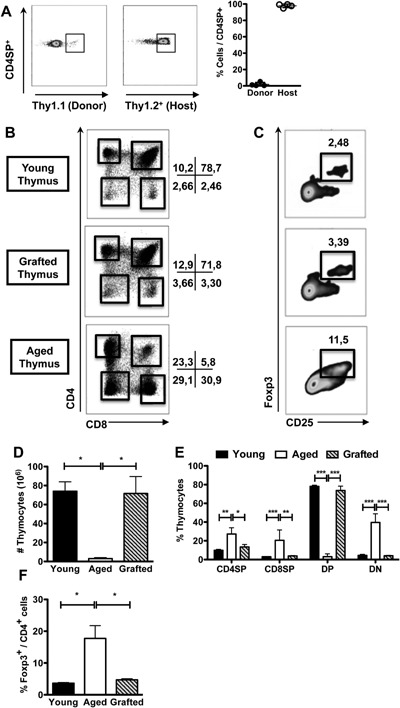Figure 3.

Aged precursors are able to differentiate in the grafted young thymus and generate thymic subsets at normal frequencies. BALB/c or C57BL/6 mice were grafted, at the age of 18 months, with one syngeneic thymus obtained from 5 to 10 days old donor. (A) Representative dot‐plots (left) show the Thy1.1 and Thy1.2 staining gated on single‐positive CD4+ (CD4SP) T lymphocytes. Scatter‐plot graph (right) shows the relative frequencies of B6Ba Thy1.1+ donor‐ and B6 Thy1.2+ host‐derived thymocytes among CD4SP present in the grafted thymuses (n = 4) 30 days after grafting. (B, C) Representative dot‐plots depict frequencies of (B) CD4+ and CD8+ and (C) CD25+ and Foxp3+ (gated on CD4SP) thymocytes present in the grafted thymuses of BALB/c mice. The same staining is shown in control BALB/c young (2 months old) and in the endogenous aged BALB/c host thymuses for comparison. (D) Absolute number of total thymocytes, (E) percentages of CD4SP, CD8+ single‐positive (CD8SP), CD4+CD8+ double‐positive (DP), CD4−CD8− double‐negative (DN), and (F) Foxp3+/CD4+ cells (among CD4SP lymphocytes) are shown in the grafted thymuses (n = 3) and compared with control young (n = 3) and endogenous aged host (n = 3) thymuses of BALB/c mice. Each circle represents one individual mouse. Data are representative from three independent experiments with similar results and statistical significance was determined by one‐way ANOVA with Bonferroni's Multiple Comparison Test (D and F) and two‐way ANOVA with Bonferroni's Multiple Comparison Test (E) (*p < 0.05, **p < 0.01, ***p < 0.001, ns, not significant).
